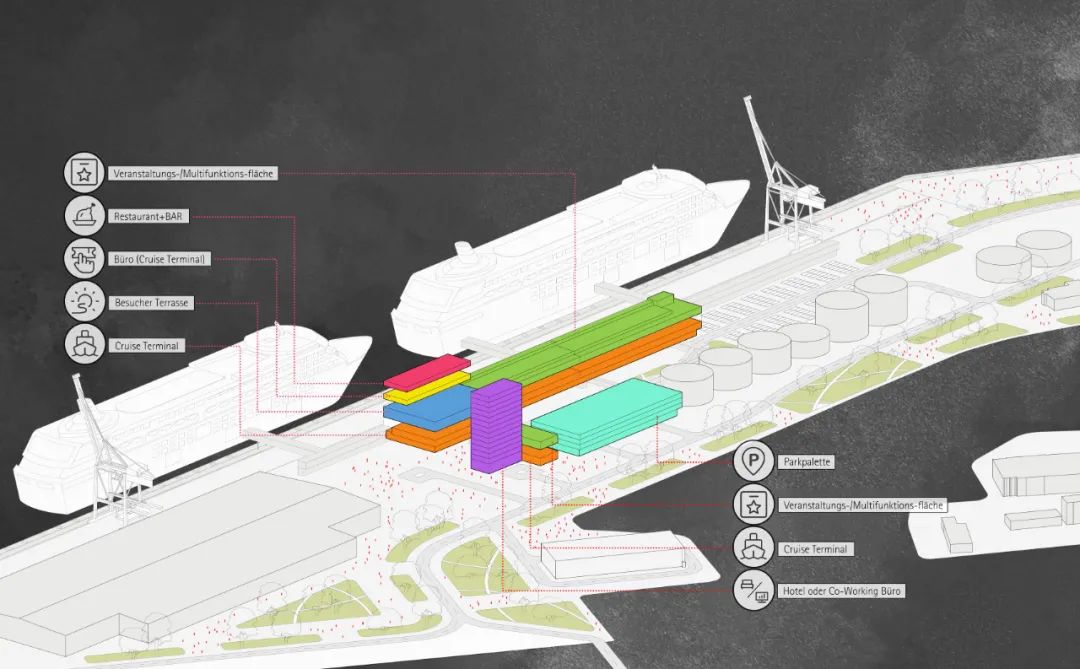- 注册
- 登录
- 小程序
- APP
- 档案号


德国gmp建筑设计有限公司 · 2023-09-14 17:39:00

效果图 © Loom Architekturvisualisierungen
gmp·冯·格康,玛格及合伙人建筑师事务所的设计方案中标建筑招标程序。该方案将翻新和扩建哥伦布邮轮码头,而不是按最初的计划拆除该建筑。这个码头历史悠久且深受游客喜爱,发展潜力巨大。早在19世纪,船客和移民就从这里启程前往新大陆。1958年,猫王埃尔维斯·普雷斯利(Elvis Presley)在数千名粉丝的欢呼声中,从这里下船来到德国服兵役。如今,哥伦布邮轮码头主要归邮轮停靠使用,并且是城市重要的经济和旅游枢纽。
The design by architects von Gerkan, Marg and Partners (gmp) proved convincing in the tendering procedure: the Columbus Cruise Terminal (CCB) will now be refurbished and extended rather than demolished as was originally planned. The terminal at the Columbuskaje boasts a long history and is as popular with citizens as with tourists, and thus has significant potential. From as early as the 19th century, voyagers and emigrants started their travels from here. In 1958, Elvis Presley disembarked here on his way to do his military service in Germany and was greeted by thousands of fans. Nowadays, the Columbus Cruise Terminal is mainly used by cruise ships and is an important commercial venture and tourist attraction for the city.

总平面图 © gmp Architekten
不来梅港自1827年建成后,成为了800万人迈向新大陆的起点。对于当地的船运公司来说,这是一项极具吸引力的业务。1927年,随着传统的哥伦布码头的开放,不来梅港巩固了它在德国和美国之间跨大西洋航路的地位。1952年到1958年兴建了现在的码头,但随着20世纪60年代航空业的蓬勃发展,传统的大西洋客运时代结束了。乘客设施以南的区域因此没有完工,而是在此用地上建造了一个仓库。所以,现在的哥伦布邮轮码头由不同功能的建筑元素组成。秉承可持续发展的理念,将保留改建这些元素,并根据最初的但未实现的构想加以扩建。例如,高层建筑的钢筋混凝土结构将通过创新型和可持续的支撑结构扩建到第15层。对此,最初的设计方案已对地基承载力进行过计算。与此同时,一等舱候船区和中央候船大厅这样的标志性室内空间以及两侧的商店将得以保留。另外,还增加了文化、餐饮和活动等其他功能。哥伦布邮轮码头东侧防洪区内的可回收停车场将提供必要的停车位。鉴于出行观念的转变,这个停车场也可以在一定时期内无损坏地被拆除。一条通道将停车场与哥伦布邮轮码头和新的公共区域相连。邮轮乘客当然还有每日游客可以在出发前在公园里消遣时间并欣赏码头景色。
Since its opening in 1827, the port served eight million people as the starting point of their journey to the New World and as such was an attractive commercial magnet for the local shipping companies. When the facility opened its famed Columbuskaje quay in 1927, it strengthened its role in transatlantic shipping between Germany and America. The current terminal was created between 1952 and 1958 but as air travel started to boom in the 1960s, the time of the classic cross-Atlantic cruise came to an end. For this reason, the sections to the south of the passenger facilities were not completed and the site for these was used to build a storage depot. In consequence, the CCB today includes elements that are used for a range of different functions. The current plan, in the spirit of sustainable development, is to retain and develop these units by converting them in line with the original ?albeit aborted ?design idea. An example is the high-rise building; using an innovative and sustainable loadbearing system, its reinforced concrete structure will be extended to the full, originally-planned 14 stories, for which the foundations are already in place. At the same time, iconic interior spaces, such as the first-class waiting area and the central waiting hall with associated shops will be retained. The functions of the cruise terminal could be expanded to include rooms for culture, food outlets, and events. A recyclable car stacker in the flood-protected area to the east of the Columbus Cruise Terminal will provide the required parking spaces. In the medium term this could be dismantled in a nondestructive way if required as part of the mobility transition. A gangway will provide a direct link to the CCB and the new public facilities. There will also be a park where ship passengers can relax while awaiting their departure and where day visitors can enjoy watching the goings-on at the terminal.

功能现状 © gmp Architekten
长远来看,gmp 的整体设计方案是在模块化原则的基础上实施场地开发,从而加强整个地区的实力。此外,哥伦布邮轮码头在改建期间仍将继续运营,乘客仍可办理登船手续。
In this way, gmp's holistic concept provides a long-term solution for the implementation of a development plan based on a modular principle that will enhance the entire area. While conversion work is going on, the Columbus Cruise Terminal will remain operational and passenger handling can continue.

改造后的功能分析 © gmp Architekten
对现有建筑的保留利用了建筑中已经蕴含的灰色能源。新的老哥伦布邮轮码头不仅由此成为一个可持续发展项目,可再生能源的使用、抽取海水用于被动式供暖和制冷以及光伏发电都为碳平衡做出了积极的贡献。
By retaining the existing structure it is possible to make use of the gray energy embedded in the fabric. But this is not the only approach that makes the new/old Columbus Cruise Terminal a project based on sustainable ideas. In addition, a positive CO2 balance is achieved by using renewable energy, by using sea water for passive heating and cooling, and by installing photovoltaic elements for the generation of electricity.
设计:尼古劳斯·格茨与扬·博拉斯科
竞争性谈判项目负责人:凯·里策克
竞争性谈判团队:Monika Franz, Jesko Hammersen, Kristina Loock, Maren Lucht, Liselotte Knall, Josepha Schacht, Karsten Schillings, Urs Wedekind, 张名扬
业主:不来梅港口有限公司
Design Nikolaus Goetze and Jan Blasko
Project Lead, Negotiated Procedure Kai Ritzke
Design Team, Negotiated Procedure Monika Franz, Jesko Hammersen, Liselotte Knall, Kristina Loock, Maren Lucht, Josepha Schacht, Karsten Schillings, Urs Wedekind, Zhang Mingyang
Client bremenports GmbH
特别声明
本文为自媒体、作者等档案号在建筑档案上传并发布,仅代表作者观点,不代表建筑档案的观点或立场,建筑档案仅提供信息发布平台。
23
好文章需要你的鼓励

 参与评论
参与评论
请回复有价值的信息,无意义的评论将很快被删除,账号将被禁止发言。
 评论区
评论区